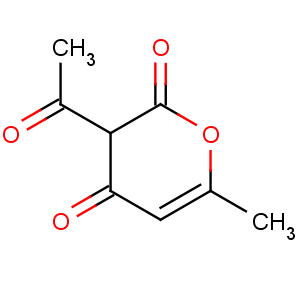Title: Dehydroacetic Acid
CAS Registry Number: 520-45-6
CAS Name: 3-Acetyl-6-methyl-2
H-pyran-2,4(3
H)-dione
Synonyms: 2-acetyl-5-hydroxy-3-oxo-4-hexenoic acid d-lactone; methylacetopyronone; DHA
Molecular Formula: C8H8O4
Molecular Weight: 168.15
Percent Composition: C 57.14%, H 4.80%, O 38.06%
Literature References: Polymerization product of ketene: Steele
et al., J. Org. Chem. 14, 460 (1949). From ethyl acetoacetate: Arndt,
Org. Synth. coll. vol. III, 231 (1955). Toxicity study: H. C. Spencer
et al., J. Pharmacol. Exp. Ther. 99, 57 (1950). Series of articles on toxicity studies, pharmacology, mechanism of action, absorption, distribution, renal action:
ibid. 57-111.
Properties: White to cream crystalline powder, mp 109-111° (sublimes). bp 269.9°. Soly (w/w at 25°): in acetone 22%; benzene 18%; methanol 5%; carbon tetrachloride 3%; U.S.P. ethanol 3%; ether 5%; glycerol <0.1%,
n-heptane 0.7%; olive oil 1.6%; propylene glycol 1.7%; water <0.1%. LD50 orally in rats: 1000 mg/kg (Spencer).
Melting point: mp 109-111° (sublimes)
Boiling point: bp 269.9°
Toxicity data: LD50 orally in rats: 1000 mg/kg (Spencer)
Derivative Type: Sodium salt hydrate
Trademarks: DHA-S (Dow)
Molecular Formula: C8H7NaO4.H2O
Molecular Weight: 208.14
Percent Composition: C 46.16%, H 4.36%, Na 11.05%, O 38.43%
Properties: Tasteless white powder. Soly (w/w at 25°): in water 33%; propylene glycol 48%; olive oil <0.1%; methanol 14%; U.S.P. ethanol 1%;
n-heptane <0.1%; glycerol 15%; ether <0.1%; carbon tetrachloride <0.1%; benzene <0.1%; acetone 0.2%. LD50 orally in rats: 570 mg/kg (Spencer).
Toxicity data: LD50 orally in rats: 570 mg/kg (Spencer)
Use: In organic syntheses; as plasticizer, compatible with nitrocellulose, polystyrene, methacrylate, vinylite resins; as fungicide and bactericide; in antienzyme toothpastes; to reduce pickle bloating.

